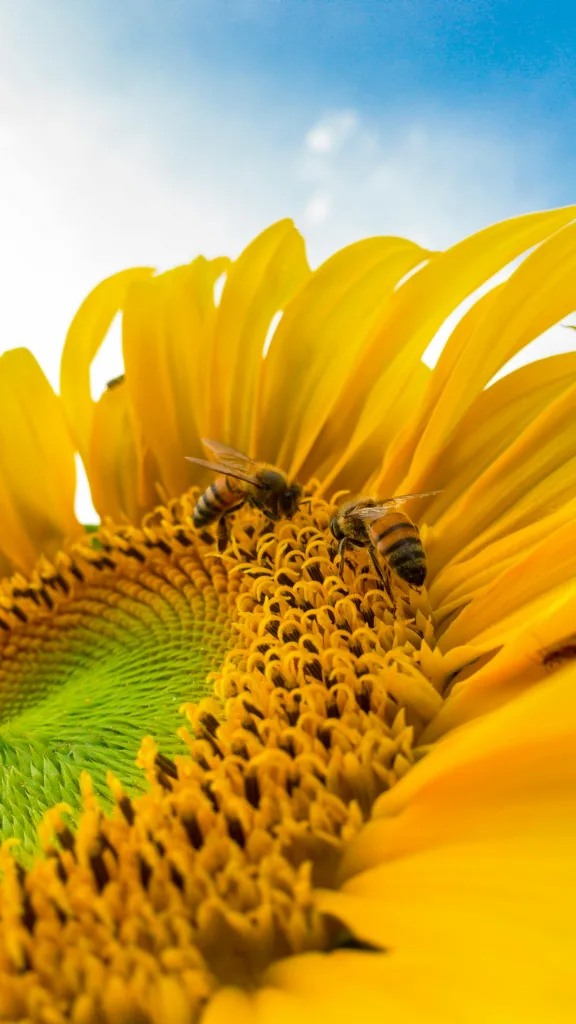Ultimo aggiornamento il 27 giugno 2025 da Vita Ecologica
Fluttuare come una farfalla, fiutare il cancro come un'ape.
Un nuovo studio ha deciso di esplorare l'eccellente olfatto delle api da miele per scoprire se possono rilevare il cancro ai polmoni. È emerso che le api da miele possono rilevare i sottili odori del cancro ai polmoni in laboratorio. Il lieve odore di una malattia può essere rilevato persino nell'alito di un paziente. In questo articolo esploreremo la scienza alla base di questa scoperta e le sue implicazioni.
Indice dei contenuti
La scienza dietro la scoperta
Informazioni sulle capacità sensoriali delle api
Le api da miele sono famose per il loro straordinario senso dell'olfatto, che permette loro di rilevare e distinguere un'ampia varietà di odori a concentrazioni incredibilmente basse. Questa capacità è fondamentale per la loro sopravvivenza, in quanto le aiuta a localizzare i fiori, a comunicare con le altre api e a orientarsi nel loro ambiente.
L'alito umano contiene biomarcatori (odoranti) che possono essere utilizzati per la diagnosi precoce delle malattie. Il sistema olfattivo delle api, ospitato principalmente nelle antenne, è così sensibile da poter rilevare molecole odoranti in concentrazioni che vanno da parti per miliardo a parti per trilione. Questa precisione ha suscitato interesse nella comunità scientifica, portando alla ricerca di come le capacità olfattive delle api possano essere utilizzate per rilevare composti specifici associati a malattie umane, come il cancro ai polmoni.
L'esperimento
In uno studio innovativo, i ricercatori hanno esplorato il potenziale dell'uso dei circuiti neuronali olfattivi delle api per rilevare i biomarcatori nel respiro umano. L'alito umano contiene composti organici volatili (COV), che fungono da biomarcatori per varie malattie, tra cui il cancro ai polmoni.
Gli scienziati hanno collegato il cervello di api vive a degli elettrodi, hanno fatto passare diversi profumi sotto le loro antenne e hanno registrato i loro segnali cerebrali.
"È molto chiaro, come il giorno e la notte, se [un'ape] sta rispondendo a un segnale chimico o meno".
Dabajit Saha, ingegnere neurale presso la Michigan State University di East Lansing.
Le api sono state tenute in posizione con imbracature di plastica stampate in 3D e un po' di cera, mentre i ricercatori hanno eseguito un intervento chirurgico al cervello delle api, collegando dei fili alla regione che elabora gli odori. Un dispositivo ha poi inviato soffi d'aria alle antenne degli insetti.
Ogni boccata poteva contenere una miscela di odori contrastanti, come quelli espirati dalle persone sane. Un'altra miscela imitava l'alito dei pazienti affetti da cancro ai polmoni, che contengono odori distinti che il naso umano non è in grado di rilevare. Utilizzando i segnali elettrici letti dal cervello delle api, i ricercatori sono stati in grado di distinguere tra i due tipi di alito sintetico almeno 93% delle volte.
In un esperimento separato, il team di Saha ha raccolto l'aria che indugiava sopra le cellule polmonari coltivate in laboratorio. Le api sono riuscite a distinguere i campioni d'aria prelevati in prossimità di cellule sane da quelli raccolti in prossimità di cellule di due tipi di cancro: il cancro del polmone a piccole cellule e il cancro del polmone non a piccole cellule.
Il team di Saha spera di utilizzare il sensore olfattivo delle api per testare il respiro dei pazienti affetti da cancro. Il punto debole del dispositivo è che dura solo poche ore prima che la salute del cervello delle api si affievolisca e le risposte diventino instabili. Ma funziona velocemente e fornisce risultati in tempo reale. Con un solo cervello d'ape, dice Saha, il suo team potrebbe teoricamente testare più di 100 campioni.
Implicazioni per la diagnostica medica
Il tumore al polmone è una delle forme di cancro più letali al mondo, in gran parte a causa della difficoltà di individuarlo nelle fasi iniziali (in parte perché fino a poco tempo fa il tumore al polmone era una delle forme di cancro meno finanziate e quindi meno studiate). Gli attuali metodi diagnostici, come la TAC a basso dosaggio e le biopsie tissutali, sono efficaci ma presentano diversi limiti. Queste procedure possono essere invasive, costose e spesso vengono utilizzate solo dopo la comparsa dei sintomi, il che può essere troppo tardi per un trattamento efficace.
La scoperta che le api da miele possono rilevare i biomarcatori del cancro ai polmoni attraverso il loro sistema olfattivo rappresenta un approccio rivoluzionario alla diagnostica del cancro ai polmoni. A differenza dei metodi esistenti, che si basano sulla diagnostica per immagini o sul campionamento invasivo, il rilevamento basato sulle api offre un'alternativa non invasiva che potrebbe essere effettuata in una fase molto più precoce. Questo metodo potrebbe portare a interventi più tempestivi, migliorando significativamente i risultati dei pazienti.
Sfide e considerazioni
Sebbene i potenziali benefici della diagnostica basata sulle api siano significativi, l'integrazione di questo metodo nella pratica medica tradizionale presenta delle sfide. Una delle principali preoccupazioni è la scalabilità: come possiamo gestire in modo affidabile le api su larga scala per individuare in modo coerente il cancro ai polmoni? Lo sviluppo di protocolli standardizzati e la garanzia di risultati coerenti in contesti diversi richiederanno un'attenta pianificazione. Inoltre, dobbiamo considerare le implicazioni etiche dell'uso di creature viventi nella diagnostica medica, compreso l'impatto sulle popolazioni di api e la responsabilità di prendersi cura di questi insetti vitali.
L'ideale sarebbe imparare come fanno le api e sviluppare macchine in grado di imitare le loro capacità olfattive. Purtroppo, non abbiamo ancora nulla con una tale risoluzione.
Api e sostanze chimiche per sempre
Altri esperimenti condotti dal team di Saha hanno dimostrato che le capacità olfattive delle api si estendono anche ad altre tracce di odore, come quelle emesse dalle sostanze perfluoroalchiliche e polifluoroalchiliche, comunemente note come PFAS, o sostanze chimiche per sempre. "Questo mi ha lasciato di stucco", dice. "I PFAS nell'ambiente sono molto, molto difficili da rilevare".
Cosa sono i PFAS?
I PFAS sono un gruppo di sostanze chimiche sintetiche utilizzate in un'ampia gamma di applicazioni industriali e prodotti di consumo sin dagli anni '40. Si trovano comunemente nelle pentole antiaderenti, negli indumenti idrorepellenti, nei tessuti e nei tappeti antimacchia, nelle schiume antincendio e in molti altri prodotti che resistono a grasso, acqua e olio. Se da un lato la loro durata li rende utili in queste applicazioni, dall'altro significa che non si decompongono facilmente, causando una diffusa contaminazione ambientale.
Nel corso degli anni, i PFAS sono stati rilevati nelle riserve idriche, nel suolo, nell'aria e persino nel sangue di uomini e animali. Questa contaminazione diffusa è preoccupante perché l'esposizione ad alcuni PFAS è stata collegata a effetti negativi sulla salute, tra cui cancro, danni al fegato, disfunzioni del sistema immunitario e problemi di sviluppo nei bambini.
Una guida alle sostanze chimiche per sempre (PFAS).
Le implicazioni

Questa ulteriore scoperta del team di Saha è significativa perché apre nuove possibilità per il monitoraggio ambientale e la protezione della salute pubblica. I metodi tradizionali per rilevare i PFAS nell'ambiente richiedono spesso attrezzature sofisticate e costose e procedure lunghe. L'uso delle api come sensori biologici potrebbe invece fornire un metodo più efficiente, economico e potenzialmente portatile per rilevare queste sostanze pericolose in tempo reale.
Naturalmente, anche in questo caso valgono le questioni etiche menzionate in precedenza: vogliamo assicurarci di non avere un impatto negativo su questa specie vitale più di quanto non sia già avvenuto. Dobbiamo fare in modo che i nostri sforzi per proteggere l'ambiente si estendano anche alla cura di questi insetti vitali e delle loro popolazioni, e puntare a una responsabilità ambientale su tutti i fronti, non solo su uno.
I bombi non superano il test della visione a colori a causa di un comune pesticida.
In conclusione
Ancora una volta, la natura si dimostra molto intelligente. La natura fornisce ciò che noi possiamo solo imitare malamente in modo artificiale. Questa scoperta ci ricorda ancora una volta la necessità di lavorare in armonia con la natura, usando la nostra intelligenza per capire e sfruttare le sue capacità.
Il cancro ai polmoni rimane una delle forme tumorali più letali a causa della mancanza di capacità di individuarlo. Le api ci hanno fornito un indizio su come si può fare. Ora, se riuscissimo a capire come scalare questa tecnica non invasiva, potremmo potenzialmente usarla per rilevare un'intera gamma di malattie e persino di inquinanti ambientali.
